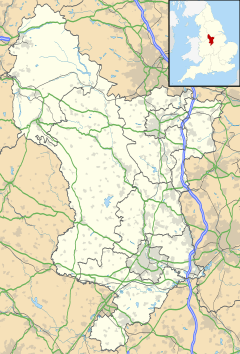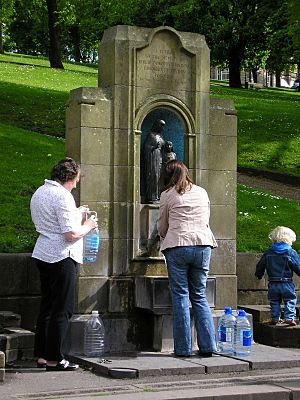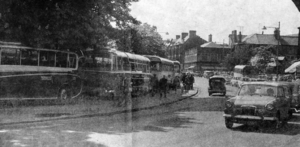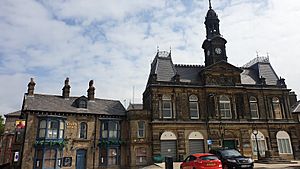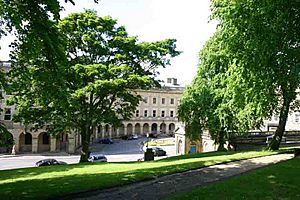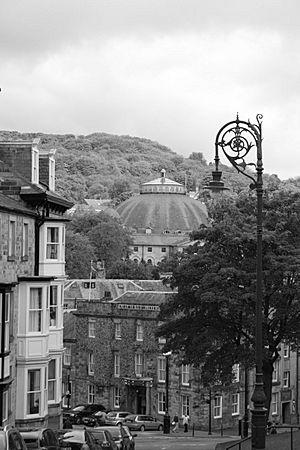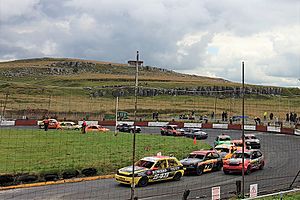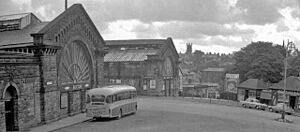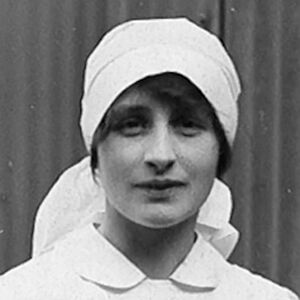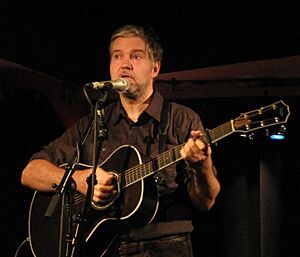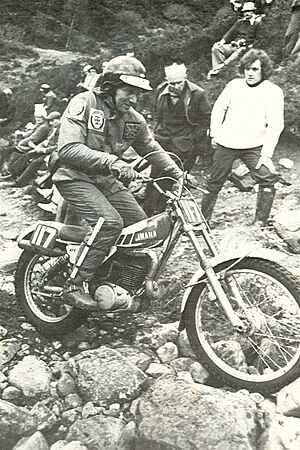Buxton facts for kids
Quick facts for kids Buxton |
|
|---|---|
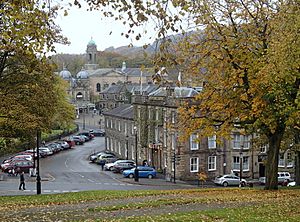 Buxton town centre |
|
| Population | 20,048 (2021) |
| OS grid reference | SK059735 |
| District |
|
| Shire county | |
| Region | |
| Country | England |
| Sovereign state | United Kingdom |
| Post town | BUXTON |
| Postcode district | SK17 |
| Dialling code | 01298 |
| Police | Derbyshire |
| Fire | Derbyshire |
| Ambulance | East Midlands |
| EU Parliament | East Midlands |
| UK Parliament |
|
Buxton is a special spa town located in the High Peak area of Derbyshire, England. It's known as England's highest market town, sitting about 300 metres (1,000 feet) above sea level. Buxton is close to Cheshire and Staffordshire, right on the edge of the beautiful Peak District National Park. In 1974, Buxton joined with other towns like Glossop to form the High Peak local government district.
In 2011, about 22,115 people lived in Buxton. The town has many interesting places to visit, such as Poole's Cavern (a cool cave), St Ann's Well (where natural spring water comes out), and lots of old buildings. These include the amazing Buxton Crescent, the Buxton Baths, and the Buxton Opera House. Part of the University of Derby is also in Buxton. The town is also connected to Oignies in France and Bad Nauheim in Germany through a special friendship called "twinning".
Contents
History of Buxton
Ancient Roman Times
Long ago, the Romans built a settlement here called Aquae Arnemetiae. This name means "the spa of the goddess of the grove," showing that even back then, people knew about Buxton's special waters. We know the Romans were in Buxton for a long time because coins from their era have been found. The name "Buxton" itself might come from old English words meaning "Buck Stone" (deer stone) or "Rocking Stone." The town really started to grow in the late 1700s, thanks to the Duke of Devonshire, and then again in the Victorian era (the 1800s) when people believed the waters could heal them.
Buxton's Spa Boom
Buxton is built on the River Wye and is overlooked by Axe Edge Moor. It became famous as a spa town because of its natural hot spring. This spring water comes out of the ground at a steady temperature of 28°C (82°F). The water is piped to St Ann's Well, which has been a special place since medieval times. It's located near the Crescent in the town centre.
The Dukes of Devonshire have been very involved with Buxton since 1780. The 5th Duke used money from his copper mines to make Buxton a fancy spa town, much like Bath. Even earlier, in 1573, Mary, Queen of Scots, visited Buxton to "take the waters" for her health. She stayed at the place where the Old Hall Hotel is now. Buxton has also been mentioned in poems by W. H. Auden and novels by Jane Austen and Emily Brontë.
A very important person in making Buxton popular was Erasmus Darwin (the grandfather of Charles Darwin). He told his friend Josiah Wedgwood (who started the famous pottery company) about the healing waters of Buxton. The Wedgwood family loved visiting Buxton and told all their friends about it. When the railway arrived in 1863, it helped the town grow even more. The population jumped from 1,800 in 1861 to over 6,000 by 1881!
Every summer, the wells in Buxton are decorated in a local tradition called well dressing. This well dressing weekend has grown into a big town carnival with live music and a funfair. In 2013, Buxton was even named one of the three most attractive towns in Britain!
Geography and Geology
Buxton is built on the edge of two different types of rock: older limestone and younger shale, sandstone, and gritstone. The earliest buildings in the town, like the parish church of St Anne (built in 1625), were mostly made of limestone.
At the southern edge of town, the River Wye has carved out a large limestone cave called Poole's Cavern. Over 300 metres (330 yards) of its chambers are open for people to explore. Inside, you can see Derbyshire's largest stalactite and unique "poached egg" stalagmites. The cave is named after a famous local highwayman called Poole.
Climate
At about 300 metres (1,000 feet) above sea level, Buxton is the highest market town in England. Because it's so high up, Buxton is usually cooler than nearby towns. Daytime temperatures are often about 2°C lower than in Manchester. The Met Office has been collecting weather data for Buxton since 1908. In June 1975, the town even had a strange snowstorm that stopped a cricket match!
| Climate data for Buxton, elevation: 289m (1981-2010) Extremes (1959 - present) | |||||||||||||
|---|---|---|---|---|---|---|---|---|---|---|---|---|---|
| Month | Jan | Feb | Mar | Apr | May | Jun | Jul | Aug | Sep | Oct | Nov | Dec | Year |
| Record high °C (°F) | 13.0 (55.4) |
15.3 (59.5) |
20.0 (68.0) |
23.9 (75.0) |
25.2 (77.4) |
29.0 (84.2) |
31.0 (87.8) |
32.7 (90.9) |
25.5 (77.9) |
21.1 (70.0) |
15.7 (60.3) |
13.7 (56.7) |
32.7 (90.9) |
| Mean daily maximum °C (°F) | 5.2 (41.4) |
5.3 (41.5) |
7.7 (45.9) |
10.5 (50.9) |
14.2 (57.6) |
16.8 (62.2) |
18.9 (66.0) |
18.5 (65.3) |
15.5 (59.9) |
11.6 (52.9) |
8.0 (46.4) |
5.5 (41.9) |
11.5 (52.7) |
| Daily mean °C (°F) | 2.9 (37.2) |
2.8 (37.0) |
4.7 (40.5) |
6.9 (44.4) |
10.1 (50.2) |
12.9 (55.2) |
15.0 (59.0) |
14.6 (58.3) |
12.1 (53.8) |
8.8 (47.8) |
5.6 (42.1) |
3.2 (37.8) |
8.3 (46.9) |
| Mean daily minimum °C (°F) | 0.5 (32.9) |
0.2 (32.4) |
1.7 (35.1) |
3.2 (37.8) |
5.9 (42.6) |
8.9 (48.0) |
11.0 (51.8) |
10.7 (51.3) |
8.7 (47.7) |
5.9 (42.6) |
3.1 (37.6) |
0.8 (33.4) |
5.1 (41.2) |
| Record low °C (°F) | −14.4 (6.1) |
−13.3 (8.1) |
−11.1 (12.0) |
−8.0 (17.6) |
−2.9 (26.8) |
−0.4 (31.3) |
2.2 (36.0) |
2.5 (36.5) |
−0.6 (30.9) |
−6.2 (20.8) |
−9.3 (15.3) |
−14.0 (6.8) |
−14.4 (6.1) |
| Average precipitation mm (inches) | 136.5 (5.37) |
100.4 (3.95) |
113.7 (4.48) |
89.9 (3.54) |
77.1 (3.04) |
90.4 (3.56) |
87.8 (3.46) |
100.1 (3.94) |
107.3 (4.22) |
147.1 (5.79) |
133.4 (5.25) |
145.7 (5.74) |
1,329.4 (52.34) |
| Average precipitation days (≥ 1.0 mm) | 17.0 | 13.6 | 15.5 | 12.6 | 11.9 | 12.6 | 12.7 | 13.5 | 12.7 | 16.2 | 16.3 | 16.4 | 171.0 |
| Mean monthly sunshine hours | 41.2 | 63.1 | 93.8 | 140.2 | 180.2 | 166.4 | 178.5 | 167.6 | 123.8 | 91.4 | 51.0 | 37.7 | 1,334.8 |
| Source 1: Met Office | |||||||||||||
| Source 2: KNMI | |||||||||||||
| Climate data for Buxton, elevation: 307m (1971–2000) | |||||||||||||
|---|---|---|---|---|---|---|---|---|---|---|---|---|---|
| Month | Jan | Feb | Mar | Apr | May | Jun | Jul | Aug | Sep | Oct | Nov | Dec | Year |
| Mean daily maximum °C (°F) | 4.9 (40.8) |
5.0 (41.0) |
7.4 (45.3) |
9.9 (49.8) |
13.8 (56.8) |
16.4 (61.5) |
18.6 (65.5) |
18.1 (64.6) |
14.9 (58.8) |
11.0 (51.8) |
7.4 (45.3) |
5.7 (42.3) |
11.1 (52.0) |
| Mean daily minimum °C (°F) | −0.1 (31.8) |
−0.1 (31.8) |
1.4 (34.5) |
2.8 (37.0) |
5.5 (41.9) |
8.6 (47.5) |
10.7 (51.3) |
10.4 (50.7) |
8.3 (46.9) |
5.3 (41.5) |
2.3 (36.1) |
0.8 (33.4) |
4.7 (40.5) |
| Average precipitation mm (inches) | 139.2 (5.48) |
101.0 (3.98) |
119.5 (4.70) |
84.6 (3.33) |
73.8 (2.91) |
90.3 (3.56) |
76.7 (3.02) |
93.3 (3.67) |
101.9 (4.01) |
137.9 (5.43) |
135.8 (5.35) |
145.9 (5.74) |
1,299.9 (51.18) |
| Source: KNMI | |||||||||||||
Amazing Buildings
Because so many people visited Buxton for its special waters, especially in the 1700s and 1800s, many beautiful new buildings were constructed to welcome them.
The Old Hall Hotel is one of the oldest buildings in town. It was once owned by George Talbot, 6th Earl of Shrewsbury, and his wife, Bess of Hardwick. They were the "gaolers" (keepers) of Mary, Queen of Scots, who visited Buxton several times to use the waters. The current building dates back to 1670.
The famous Grade I listed Buxton Crescent was built between 1780 and 1784 for the 5th Duke of Devonshire. He wanted to make Buxton a very fashionable spa town. The Crescent was designed by architect John Carr, and it looks a bit like the Royal Crescent in Bath. Nearby, the Great Stables were also built, which later became a hospital for the "sick poor" in 1859. This hospital became known as the Devonshire Royal Hospital in 1934.
Later, the amazing Devonshire Dome was added. It has the world's largest unsupported dome, measuring 44 metres (144 feet) across! This was even bigger than the domes of the Pantheon in Rome and St Paul's Cathedral in London at the time. Today, this impressive building and the surrounding Victorian villas are part of the University of Derby.
Architect Henry Currey also designed the Buxton Baths, which opened in 1854 on the site of the old Roman baths. The Thermal Baths closed in 1963 but were later beautifully restored and turned into a shopping area called the Cavendish Arcade. A famous artist named Brian Clarke created a stunning stained glass ceiling for the arcade, which was the largest stained glass window in the British Isles at the time. Visitors could drink the spring water at The Pump Room until 1981. In 2020, the Crescent reopened as a fancy 5-star spa hotel after a 17-year renovation. Right next to it is St Ann's Well, added in 1940.
When the railways came to Buxton in 1863, Buxton railway station was designed by Joseph Paxton. He was also the gardener and architect for the 6th Duke of Devonshire and is most famous for designing the Crystal Palace in London! Buxton Town Hall, designed by William Pollard, was finished in 1889.
Other Cool Buildings
The Buxton Opera House, designed by Frank Matcham in 1903, is the highest opera house in the country. Matcham designed many famous theatres in London, like the London Palladium. Next to the opera house are the Buxton Pavilion Gardens, which opened in 1871. These gardens are huge, covering 93,000 square metres (about 23 acres) with beautiful gardens and ponds. They are a very important historic public park.
The 122-room Palace Hotel, built in 1868, stands out on the hill above the railway station. Many of Buxton's old pubs and inns are also listed buildings, showing the town's long history.
Culture and Fun
Buxton is a lively town with many cultural events throughout the year. These include the annual Buxton Festival, performances at the Buxton Opera House, and shows at other venues. The Buxton Museum and Art Gallery also has interesting exhibitions all year round.
Buxton Festival
The Buxton Festival started in 1979 and is a big opera and arts event held every July. It features literary talks in the mornings, concerts in the afternoons, and often rare operas in the evenings. There's also the Buxton Festival Fringe, which is like a warm-up for the famous Edinburgh Fringe. The Buxton Fringe has drama, music, dance, comedy, poetry, art shows, and films happening all over town.
Other Festivals
In February, the Four Four Time music festival brings different kinds of music, including rock, pop, folk, blues, jazz, and world music. The International Gilbert and Sullivan Festival, a three-week theatre event, was held in Buxton for many years and returned in 2023.
The Opera House has a year-long schedule of plays, concerts, comedy, and other events. The Pavilion Arts Centre, located behind the Opera House, reopened in 2010 after a big renovation. It has a 369-seat theatre.
The Buxton Museum and Art Gallery displays local historical items, geological and archaeological samples, and paintings from the 1800s and 1900s. They also show work by local artists. The Pavilion Gardens often host arts, crafts, antiques, and jewellery fairs.
Buxton's Well Dressing Festival takes place in the week leading up to the second Saturday in July. This tradition has been going on since 1840 to celebrate the fresh water supply in the town's marketplace. Besides decorating the wells, there's a carnival parade and a funfair. Well dressing is an old custom unique to the Peak District and Derbyshire. People believe it dates back to Roman and Celtic times when communities would decorate wells to thank them for fresh water.
Economy and Jobs
Buxton's economy includes many different things like tourism, shops, quarrying (digging for stone), scientific research, light industry, and bottling mineral water. The University of Derby is also a big employer. Since Buxton is surrounded by the Peak District National Park, tourism is a major industry, with over a million visitors each year. Buxton is the main place for people to stay overnight when they visit the Peak District.
The Buxton Mineral Water Company, owned by Nestlé, bottles the famous mineral water from the town's springs. The Buxton Advertiser is the local newspaper that comes out every week. Potters of Buxton is the town's oldest department store, started in 1860.
Quarrying
The Buxton lime industry has been very important to the town's growth since the 1600s. Several limestone quarries are located nearby. One of them, the "Tunstead Superquarry," is the largest producer of high-purity industrial limestone in Europe and employs 400 people. The quarrying industry also provides jobs in processing and distributing limestone. Another important employer is the Health & Safety Laboratory, which does research and investigates incidents related to health and safety, employing over 350 staff locally.
Education
Buxton is home to a University of Derby campus at the site of the old Devonshire Royal Hospital. There's also the Buxton & Leek College, which was formed in 2012.
For secondary education, there's Buxton Community School and St. Thomas More Catholic School. There are also many primary schools in and around Buxton, such as Buxton Junior School, St Anne's Catholic Primary, Harper Hill School, and Fairfield Endowed Junior.
Sports and Groups
Above the town, there are two small tracks for speedway racing. Buxton Raceway (also known as High Edge Raceway) is a motor sports circuit that opened in 1974. It hosts banger and stock car racing, as well as drifting events. The speedway team, Buxton High Edge Hitmen, used to race here.
Buxton's football team, Buxton F.C., plays at Silverlands. The Buxton Cricket Club plays at the Park Road ground. Other sports clubs include Buxton Rugby Union and Buxton Hockey Club.
Buxton has two 18-hole golf courses. Cavendish Golf Club is considered one of the top 100 in England. It was designed by the famous Alister MacKenzie and opened in 1925. The Buxton & High Peak Golf Club at Fairfield is the oldest in Derbyshire, founded in 1887.

The hills around Solomon's Temple are popular for bouldering (a type of rock climbing). Hoffman Quarry at Harpur Hill is a local spot for sport climbing.
For young people, there are groups like the Kaleidoscope Youth Theatre, Buxton Squadron Air Cadets, Derbyshire Army Cadet Force, and the Sea Cadet Corps. There are also local Scouts and Guide groups.
Media
Local TV news for Buxton comes from BBC North West and ITV Granada, which are based in Salford. You can listen to local radio stations like BBC Radio Derby on 96.0FM and Greatest Hits Radio Derbyshire (High Peak) on 106.4FM. The Buxton Advertiser is the town’s weekly local newspaper.
Getting Around
Trains
Buxton railway station has trains every half hour to Stockport and Manchester Piccadilly on the Buxton line. These trains are run by Northern. The journey to Manchester takes just under an hour.
Train History
Buxton used to have three train stations! Two belonged to the LNWR: Buxton and Higher Buxton (which closed in 1951). The third was Buxton (Midland), which closed in 1967 and is now the site of the Spring Gardens shopping centre. Part of the old railway line, called the Monsal Trail, is now a path for walking and cycling.
Heritage Railways
Peak Rail, a group that restores old railways, has brought back a section of the line from Rowsley South to Matlock. They hope to eventually reopen the line all the way to Buxton.
Buses
Buses in Buxton connect the town to other places across the Peak District National Park, including nearby towns like Whaley Bridge, Chapel-en-le-Frith, New Mills, Glossop, and Ashbourne.
The High Peak Transpeak service runs hourly south to Taddington, Bakewell, Matlock, Belper, and Derby. The Skyline 199 route runs every half hour during the day to Manchester Airport, going through New Mills and Stockport. Other bus services link Buxton to Macclesfield, Leek, Stoke-on-Trent, Sheffield, Chesterfield, and Meadowhall.
Airports
The closest airports are Manchester Airport (about 35 km or 22 miles away), Liverpool John Lennon Airport (about 77 km or 48 miles), and East Midlands Airport (about 84 km or 52 miles).
Famous People from Buxton
Many interesting people have connections to Buxton:
- Vera Brittain (1893–1970), a famous author who wrote Testament of Youth, lived in Buxton for ten years.
- Robert Stevenson (1905–1986), born in Buxton, directed many Disney films, including Mary Poppins.
- Tim Brooke-Taylor (1940–2020), a funny actor from the comedy group The Goodies.
- Lloyd Cole (born 1961), a musician and songwriter, was born in Buxton.
- Bruno Langley (born 1983), an actor known for roles in Doctor Who and Coronation Street, grew up in Buxton.
- Lucy Spraggan (born 1991), a musician, went to school in Buxton.
- Kate Butch, a drag queen from RuPaul's Drag Race UK, grew up in Buxton.
- Mick Andrews (born 1944), a former international motorcycle trials rider, was born in Buxton.
- Les Bradd (born 1947), a former footballer and the top goalscorer for Notts County.
- Abbie Wood (born 1999), a swimmer who competed in the 2020 Summer Olympics, was born in Buxton.
Buxton in Books
Buxton has appeared in several books:
- A series of mystery novels by Sarah Ward are partly based on Buxton's Georgian architecture.
- Bill Bryson writes about his visit to Buxton in his 2015 book The Road to Little Dribbling.
- Vera Brittain mentions growing up in Buxton in her memoir Testament of Youth.
- The famous book Ulysses by James Joyce mentions Buxton as a place to go "for the waters."
- The Victorian diarist Anne Lister wrote about her visit to Buxton in her journal in 1816.
Images for kids
See also
 In Spanish: Buxton para niños
In Spanish: Buxton para niños


